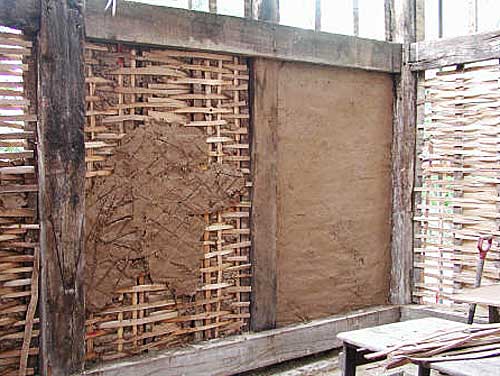Now that he was looking at it more closely, he realised that this wall was different in construction to the other three sides of the room. Whilst the others had the typical brushed look of traditional wattle and daub structures, and each wall was a single sheet of the stuff, this one was made up of more than a dozen sections, a criss-cross framework with only the lumpy runnels of thickened mud dried between them. The hole his head had made was smack-bang in the middle of one of these smaller frames, and Marius could see that the edges were thin and brittle, as if there was no internal structure holding the mud together. He gripped the edge of the hole and pulled. A sheet of daub the length of his forearm came away, shattering against the floor. Marius looked at it in amazement.
"No wattle," he said to himself. "No damn wattle! But how…?"
The Corpse-Rat King, Lee Battersby
________
Usually I can get what something is from the context, but here all I was able to figure out was that wattle and daub was some sort of construction material. I was curious as to why Marius would be so amazed that there was no damn wattle.
So I had to look it up.
Wattle is a woven lattice of material -- wood, etc. -- onto which a sticky substance (clay, usually) is daubed. The technique is 6,000 years old, although Wikipedia says not only do some parts of the world still use it, but it's becoming more popular as a sustainable building technique.
But despite Wikipedia's assurances that this was becoming more popular nowadays, I couldn't find any other reference claiming that we 21st Century folk were starting to build our 14,000-square-foot McMansions with mud-based materials. It seems more aspirational on the part of whichever Wikipedia editor slipped that bit of information into the wattle-and-daub entry. Hmmm I bet I can get my Wattle'n'Daub Home Construction Manual to sell better with some judicious editing.
That same person also seems to have been at work on the linked page explaining the similar technique of cob, a form of building that involves simply mounding clay and straw and the like into a large wall; the entry for cob tells us that
Cob is fireproof, resistant to seismic activity,[2] and inexpensive. It can be used to create artistic, sculptural forms and has been revived in recent years by the natural building and sustainability movements.
The footnote is to this 2007 article in the Seattle Post-Intelligencer, which asks the obviously-rhetorical question "Thinking Of Building A Cob Home?" Contrary to the 'fact' that cob is 'resistant to seismic activity,' the article quotes the Seattle Building Inspector as noting cob would cause concerns because Seattle gets earthquakes. The article asserts that a study was done on cob's ability to withstand earthquakes, and 'according to one account' cob did very well, per the article. Since scientific studies are not usually anecdotal, I checked that out, too.
A 2012 UBC study investigated using "cob and/or straw bales" to build nonresidential structures. It notes that a cob structure in California "had to be reinforced with other non-natural and semi-natural materials like adobe and steel beams" and that such buildings are "structurally unpredictable." Just what you want in a sustainable home!
People thinking of building their home out of cob should note what I assume to be a heavily-sarcasm-laden quote from that building inspector about whether you could build a home out of cob:
"In a sense, there's no material that couldn't possibly be used."
Straw, sticks, whatever you want: go wild, sustainable building folk! Why not Silly Putty, so your house could be decorated with impressions of the Sunday comics on all its walls?

2 comments:
No,no.
We want to build a home out of Lego. That way, if we want to change it around at any point, we can. We're just still collecting the pieces.
That.
Would.
Be.
Incredible!
Post a Comment